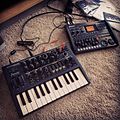Arturia: Difference between revisions
| Line 40: | Line 40: | ||
* Solina V |
* Solina V |
||
* Matrix12 V |
* Matrix12 V |
||
* Spark 2 (for use with Spark and Spark LE hardware controllers) |
|||
}} |
}} |
||
Revision as of 10:31, 23 February 2015
 | |
| Company type | Privately Held Corporation |
|---|---|
| Industry | electronics |
| Founded | 1999 in Grenoble |
| Founders | Frédéric Brun, Gilles Pommereuil |
| Headquarters | Grenoble |
| Products |
|
Number of employees | 13 |
| Website | arturia |
Arturia is an electronics company founded in 1999 and based in Grenoble, France. The company designs and manufactures electronic musical instruments, including softsynths and vintage analog synthesizers. Their most prominent analog machines are the monophonic synthesizers, MiniBrute and MicroBrute.
Arturia has won several awards and other recognitions for their products.
History
Arturia was founded in 1999 by INPG engineers Frédéric Brun and Gilles Pommereuil in Grenoble to create affordable software synthesizers. The first product they developed was Storm, a Virtual Studio Technology.[1] The close emulation of classic analog synthesizers helped the company gain popularity in its market.[2] In order to create sounds with minimal digital artifacts, Brun and Pommereuil developed new software algorithms to eliminate these issues.[3]
In 2003, using the algorithms they had developed, Arturia worked with Bob Moog to create the Moog Modular V (MMV) softsynth. The MMV uses True Analog Emulation in an attempt to faithfully reproduce the oscillators, filters, and other modules from the Moog 3C and Moog 55.[3][4] Following this, Arturia continued to develop software emulations of well known synthesizers, including the ARP 2600, Roland Jupiter-8, Minimoog, and Sequential Circuits Prophet-5.
Arturia broke into the hardware synth market in 2012 with the MiniBrute, a vintage-style 25-key monophonic analog synthesizer with one VCO, two low-frequency oscillators, and a multimode Steinberg filter.[5] The synthesizer was introduced at the 2012 NAMM Show.[6] In the following year, Arturia announced their next hardware synthesizer, the MicroBrute, a smaller and more affordable version of the MiniBrute with minikeys, a patch bank, and a sequencer.[7] Arturia has also produced MIDI controllers and audio interfaces.
Sales
Exports to the United States, Japan, and Northern Europe account for 90% of Arturia's revenue.[2]
Products
Software synthesizers
Hardware synthesizers
Audio equipment and controllers
Gallery
-
Arturia MiniBrute (2012)
-
Arturia MicroBrute (2013) with ZOOM R8
-
Arturia BeatStep (2014)
-
Arturia BeatStep Pro (2015)
-
Arturia AudioFuse (2015)
References
- ^ Courdavault, Adrien (19 January 2015). "Meet the programmers: Arturia" (Interview). MusicRadar. Retrieved 3 February 2015.
- ^ a b "Arturia - Musical Instruments Herstellerprofil" (in German). Bonedo. Retrieved 3 February 2015.
- ^ a b Pommereuil, Gilles (2 January 2005). "Gilles Pommereuil" (Interview). Interviewed by Cyril Colom. Mixound. Retrieved 3 February 2015.
- ^ "Arturia Moog Modular V". Vintage Synth Explorer. Retrieved 3 February 2015.
- ^ "Arturia MiniBrute". Vintage Synth Explorer. Retrieved 3 February 2015.
- ^ Rogerson, Ben (19 January 2012). "NAMM 2012: Arturia Minibrute analogue synth announced". MusicRadar. Retrieved 3 February 2015.
- ^ Rogerson, Ben (21 October 2013). "Arturia teases new new analogue synth; MicroBrute images leaked". MusicRadar. Retrieved 3 February 2015.





